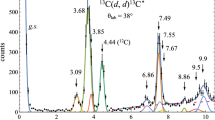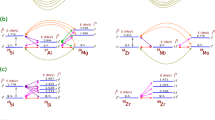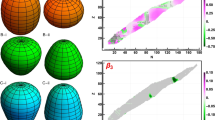Summary
The effective interaction in the s-d shell can be characterized in terms of diagonal radial matrix elements I nlSin relative states of orbital angular momentum l of two nucleons. The symmetry properties of radial matrix elements in l = 0 states are investigated. The parameters I 0sand I 2sare shown to give exact SU 3symmetry of the eigenfunctions. The SU 3-symmetry-breaking property of I 1sis explicitly demonstrated, but it is also found that in realistic calculations such an effect is somewhat suppressed by the single-particle spin-orbit force. We also show that whereas the T = 1 eigenfunctions (for J = 0, 2, 4 for two nucleons) can be very well generated from a suitable deformed intrinsic state, the T = 0 eigenfunctions (J = 1, 2, 3) generated from deformed states have poor overlaps with shell-model eigenfunctions in the absence of spin-orbit splitting of single-particle orbits. Inclusion of single-particle spin-orbit force improves very strikingly the overlaps between the generated and the shell-model T = 0 states.
Riassunto
Si può caratterizzare l’interazione effettiva nello strato s-d in termini degli elementi diagonali di matrice radiale I nlSnegli stati relativi di momento angolare orbitale l di due nucleoni. Si studiano le proprietà di simmetria degli elementi di matrice radiale negli stati con l = 0. Si dimostra che i parametri I 0se I 2sdanno una simmetria esatta SU 3 delle autofunzioni. Si dimostra esplicitamente la proprietà di rottura della simmetria SU 3, ma si trova anche che in calcoli realistici un tale effetto è in qualche modo soppresso dalla forza di spin-orbita di una singola particella. Si dimostra che, mentre le autofunzioni con T = 1 (per J = 0, 2, 4 per due nucleoni) possono essere generate da un adatto stato intrinseco deformato, le autofunzioni con T = 0 (J = 1, 2, 3), generate da stati deformati, hanno scarse sovrapposizioni con le autofunzioni del modello a guscio in assenza della separazione spin-orbita delle orbite di una singola particella. L’inclusione di una forza spin-orbita di una singola particella prova la sovrapposizione fra gli stati generati e quelli con T = 0 del modello a guscio.
Реэюме
Эффективное вэаимодействие на s-d оболочке может быть охарактериэовано в терминах диагональных злементов радиальной матрицы I nlSдля относительных состояний орбитального момента l двух нуклонов. Исследуются свойства симметрии злементов радиальной матрицы для состояний l=0. Покаэывается, что параметры I 0sи I 2sдают точную симметрию SU 3 для собственных функций. Строго рассматривается свойство нарущения симметрии SU 3 для I 1s,но также получается, что реальные вычисления такого зффекта до некоторой степени пода-влются иэ-эа одно-частичной спин-орбитальной силы. Мы также покаэываем, что тогда как T = 1 собственные функции (для J = 0, 2, 4 для двух нуклонов) могут быть получены иэ соответствуюше деформированного внутреннего состояния, при T = 0 собственные функции (J=1,2,3), обраэованные иэ деформированных состояний, имеют плохое перекрытие с собственными функциями оболочечной модели в отсутствии спин-орбитального расшепления одно-частичных орбит. Включение одно-частичной спин-орбитальной силы очень сушественно улучщает перекрытие между обраэованными состояниями T = 0 и состояниями оболочечной модели.
Similar content being viewed by others
References
J. P. Elliott: Proc. Roy. Soc., A 245, 128, 562 (1958).
M. K. Banerjee and C. A. Levinson: Phys. Rev., 130, 1036 1963; T. Inoue, et al.: Nucl. Phys., 59, 1 (1964); see also an analysis by J. C. Parikh and K. H. Bhatt: Nucl. Phys., A 103, 496 (1967), of the wave functions obtained by T. T. S. Kuo and G. E. Brown: Nucl. Phys., 85, 40 (1966).
S. P. Pandya and S. P. Pandya: Nucl. Phys., 43, 636 (1968); S. P. Pandya and J. M. Green: Nucl. Phys., 57, 658 (1964).
S. Cohen, R. D. Lawson and S. P. Pandya: Nucl. Phys., A 114, 541 (1968); S. Cohen, E. C. Halbert and S. P. Pandya: Nucl. Phys., A 114, 353 (1968).
S. Cohen, R. D. Lawson, M. H. Macfarlane and M. Soga: Methods Comp. Phys., 6, 235 (1966).
J. B. French, E. C. Halbert, J. B. McGrory and S. S. M. Wong: to be published.
S. A. Moszkowski: Proceedings of the International Conference on Nuclear Structure, Kingston (Toronto, 1960), p. 502.
S. P. Pandya: Phys. Lett., 7, 342 (1963).
M. G. Redlich: Phys. Rev., 110, 468 (1958).
Author information
Authors and Affiliations
Rights and permissions
About this article
Cite this article
Kulkarni, D.R., Pandya, S.P. SU 3 symmetry and effective interactions in the s-d shell. Nuovo Cimento B (1965-1970) 60, 199–209 (1969). https://doi.org/10.1007/BF02712363
Received:
Published:
Issue Date:
DOI: https://doi.org/10.1007/BF02712363




